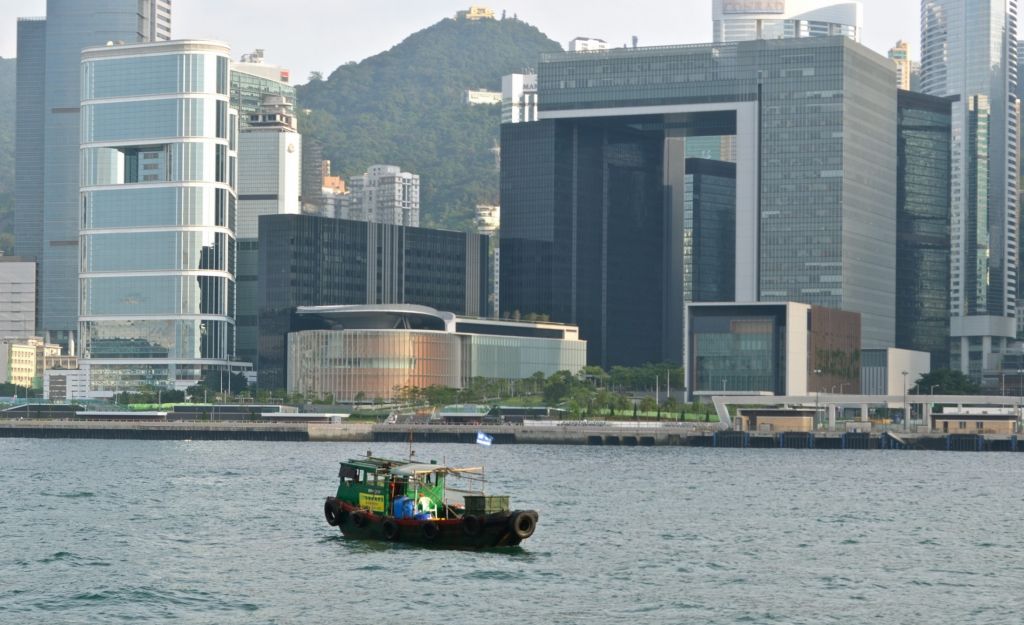If you spend more than 10 minutes in Hong Kong, you realize space is a precious commodity. The streets are crowded, the roads are crowded, the markets are crowded.
Towering apartment blocks line the Hong Kong skyline, housing a majority of city residents in flats considered small by any standard.
 A cursory glance across the skyline draws attention to gaping holes carved through the center of many buildings.
A cursory glance across the skyline draws attention to gaping holes carved through the center of many buildings.
Why would a city allow such a glaring waste of space when very square inch of real estate is precious?
The answer? Dragons.
Dragons and Feng Shui. Dismissed by Western skeptics as weirdly new-age, the art of Feng Shui is serious business in Hong Kong. Feng Shui, translated as “wind and water” stems from the ancient art of geomancy, or connecting to the energy of the earth.
One school of Feng Shui concentrates on placing a building in an environment in relation to the mountains, sea and sky.
Another school examines the influence of shape within the built and natural environment.
Most Feng Shui practitioners combine approaches when examining the design and placement of buildings/objects to ensure they are created in an auspicious and harmonious way.
Hong Kong has naturally good Feng Shui. It faces the water and is protected by mountains behind and across from it. Legend holds that dragons live in the mountains and hold positive and powerful energy. This energy blows through Hong Kong daily as the dragons make their way from the mountains to the sea to drink and bathe.
 As Hong Kong expands, builders and architects create massive structures that potentially “block” the dragons’ passage from the hills to the sea, creating bad Feng Shui and blocking the natural air flow through the city. Thus, architects plan housing and office complexes with “gates” or “windows” allowing dragons to pass through the city unimpeded on their way to the sea.
As Hong Kong expands, builders and architects create massive structures that potentially “block” the dragons’ passage from the hills to the sea, creating bad Feng Shui and blocking the natural air flow through the city. Thus, architects plan housing and office complexes with “gates” or “windows” allowing dragons to pass through the city unimpeded on their way to the sea.
 Before you dismiss Feng Shui as superstitious nonsense you should know that engineers, architects, property developers and real estate agents take Feng Shui courses before completing their training and certification.
Before you dismiss Feng Shui as superstitious nonsense you should know that engineers, architects, property developers and real estate agents take Feng Shui courses before completing their training and certification.
Prominent architectural and building firms consult Feng Shui experts at every step of a project when building in Hong Kong. Fosters + Partners incorporated Feng Shui principles when planning the iconic HSBC Hong Kong building. Foster stated “If a building has good Feng Shui, it’s probably also a good place to be.”
Bank of China architect, I. M. Pei chose to ignore these principles at his peril. Criticized for its harsh, knife-edged angles and screw shaped top, it supposedly “cut” into the good fortune of nearby neighbors. Coincidentally (or not), the nearby Lippo Center tenant went bankrupt and the first governor of Hong Kong refused to live or work in nearby Government House citing the bad Feng Shui.
Supposedly, the two rods that stand atop Foster’s HSBC building are a classic Feng Shui technique of deflecting negative energy back to its source. The rods point in the direction of the Bank of China building.
Things to Know About Hong Kong and Feng Shui
Disney consulted Feng Shui experts when designing Hong Kong Disney. The consultation resulted in shifting the main entrance angle by 12 degrees to ensure maximum prosperity. Disney also modified the main pathway from the train station to the gate to prevent the “chi” or positive energy from slipping out of the gate and into the sea.
Source:
Source Article from https://worldtruth.tv/the-mystery-behind-the-holes-why-some-buildings-in-hong-kong-have-holes/
Related posts:
Views: 0
 RSS Feed
RSS Feed

















 February 18th, 2018
February 18th, 2018  Awake Goy
Awake Goy  Posted in
Posted in  Tags:
Tags: 
















